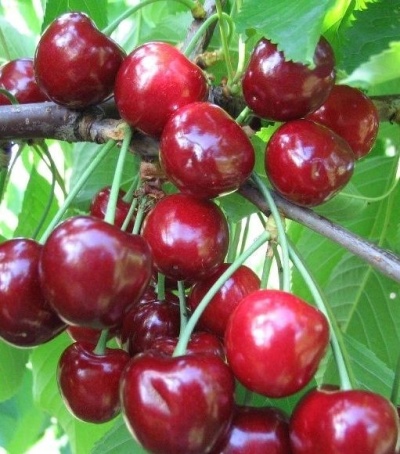
- Fruit shape: heart-shaped, one-dimensional, obtuse
- Peduncle: short, of medium thickness, easy to detach from the branch, good attachment to the bone
- Authors: A.F. Kolesnikova, E.N. Dzhigadlo, A.A. Gulyaeva, M.A. Makarkin
- Growth type: medium-sized
- Appointment: dessert
- Tree height, m: 3,2
- Crown: rare, pyramidal, raised, slightly spreading, few lentils
- Escapes: medium, straight, brownish-brown, naked
- Sheet: large, elongated, narrow oval, long pointed, dark green, wrinkled, shiny
- Fruit size: average
The present to the Eagle is a new, but rather interesting cherry variety. Bred quite recently, it has already managed to please many gardeners with its harvests and early fruiting dates.
Breeding history
The authorship of the variety belongs to domestic scientists Kolesnikova, Dzhigadlo, Gulyaeva and Makarkina. The dessert variety was obtained thanks to the seedlings pollinated by the Bigarro cherry. Breeding work was completed in 2010 and sent for variety testing. In 2017, the culture was included in the State Register for the Russian Federation.
Description of the variety
The variety has the following main characteristics:
medium-sized sweet cherry, tree height - 3.2 meters, less often - 3.5;
the bark is gray, without roughness;
shoots are brown-brown in color, grow straight, medium size;
the crown is light spreading, rises up, has the shape of a pyramid;
no special crown thickening is observed;
the foliage is narrow oval, rather long and large, shiny, painted in a dark green color, there are slight wrinkles;
the flowers look like umbrellas, they are white and medium, bloom in inflorescences (three in each);
fruits can form both on bouquet branches and on fruit twigs.
Fruit characteristics
The berries of the described variety have several characteristics that should be mentioned:
the weight of each drupe is 4.5-5 grams, and these are the average parameters among cherries;
fruits are one-dimensional, slightly dull, heart-shaped;
the skin is of an average degree of coarseness, colored in a standard red tone;
subcutaneous points are light, few and almost invisible;
a short and not too thick stalk is effortlessly separated from the branch;
the flesh is pink in color, it is rough, with cartilages;
a large bone separates perfectly from the pulp;
the juice of the Gift to the Eagle is colored pink.
Taste qualities
The taste of this sort of sweet cherry is quite high, it is 4.2. Sweet and sour fruits exude a delicate aroma and leave behind a light pleasant aftertaste.
Ripening and fruiting
The present to the Eagle is a fast-growing variety, since it forms fruits already in the third year of its existence. If flowering began earlier, the inflorescences must be removed so that in the future the strength of the tree will be directed to development. Early cherry varieties are removed from the branches in the second month of summer.

Yield
From mature fruit-bearing trees, you can collect 25 kilograms of berries.The average recorded yield of the variety is 72.06 c / ha, and the maximum is 122 c / ha.
Growing regions
The gift to the Eagle was bred for subsequent cultivation in the Central Black Earth Region.
Self-fertility and the need for pollinators
In order for berries to form on a cherry of this variety, one of the following varieties must pollinate it:
Iput;
Homeland;
Bigarro;
Valery Chkalov;
Scarlet.
And also for pollination, you can plant several cherries that bloom in May. Without pollinators A gift to the Eagle does not give a harvest.
Growing and care
In the Central Black Earth Region, cherry trees are planted in the spring. For disembarkation, a warm and bright zone is chosen, which is protected from drafts. The Gift to the Eagle variety is picky about the composition of the soil. It should be a fertile and well-drained substrate with minimal acidity, prepared in advance in the fall.
Before planting, the seedlings are soaked with roots in water for two hours, and also treated with a weak solution of potassium permanganate. They are planted in the same way as any fruit tree. After planting, be sure to add a new small layer of soil, watered and tied up. Mulching is another important post-planting step.
Abundant watering of seedlings will be required only in the first few months after planting. Plants are watered weekly, using each bucket of water. Fruit trees can rarely be watered as they have very deep roots. In a warm, calm summer, three times per season are enough. However, in case of droughts and heat, it is watered every 10 days.
In the spring, the Gift to the Eagle will require fertilizing containing nitrogen. You can use chicken manure or ammonium nitrate. In the summer months, the soil is fertilized with potassium, and in the fall, phosphorus is applied. Top dressing applied to the soil must be accompanied by abundant watering.
For the first 5-6 years, the gardener will also have to form a crown. The optimal choice is a sparse-tiered form. In addition, sanitary pruning is carried out before sap flow. If signs of disease and drying out appear on the tree, then such branches should be removed immediately, without waiting for the deterioration of the health of the culture.




Disease and pest resistance
The gift to the Eagle has good immunity. Most well he resists moniliosis and coccomycosis, but other diseases may well be affected. To prevent ailments, you need to carry out preventive spraying with fungicides and regularly prune.
But pests attack the variety much more often than diseases.Cherry flies and aphids are most common, and weevils and moths may also appear. When pests occur, insecticidal preparations are used, but it is even better to treat the trees with them in advance, prophylactically, until the harvest begins to ripen, and it does not become too dangerous.

































































